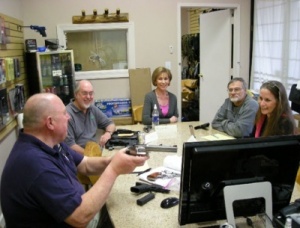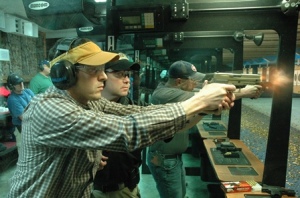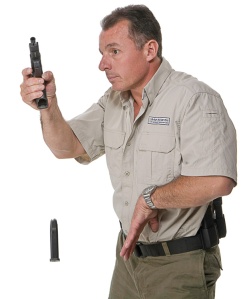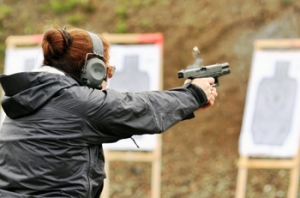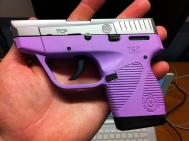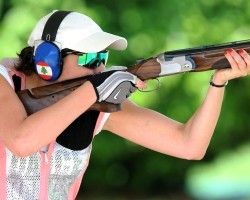While I had planned on posting an article recounting all the highlights of the year, I recently learned that a beloved member of the Autrey’s Armory family passed away. While I personally did not know him well, he was loved and cherished by all who did. In honor and respect for him, I urge you to read PeachPundit’s farewell to him. Rest in Peace, Pat Sennett.
Archive for December, 2013
How Do You Reload a Pistol?
Posted: December 12, 2013 in Self DefenseTags: empty magazine, firearm, gun, Handgun, Magazine release, Semi-automatic handgun, Semi-automatic pistol, Speed reload, Tactical Reload
Everyone who has ever shot a handgun, rifle or shotgun has faced a dilemma. You shot your 5, 6, 17 or 20 rounds and now your gun is empty. Now what? What do you have to do in order to continue shooting? Reload. The way you reload the firearm depends heavily on the type of firearm you are using, but it also depends on your preferred technique. With a revolver you can use a speed loader or manually load round by round. Rifles may be single-shot, requiring constant reloading, or they may have a magazine that can be loaded manually or with stripper clips. Shotguns come in a variety of shapes and sizes but most require individual rounds to be loaded manually into chambers or tube magazines. Semi-automatic handgun magazines may either be pre-loaded or continuously reloaded after each series of shots. The techniques involved in the insertion of a fresh magazine into a handgun, currently in use, will be the focus of the rest of this article.
To accomplish the goal of feeding your handgun more ammunition there are a number of options:
Emergency Reload
 A properly functioning, semi-automatic handgun slide will lock to the rear once the last round is fired and the magazine is empty. Once that happens to reload the gun you need to follow a series of steps; press the magazine release button, insert a new magazine, and release the slide forward. Now there are two, much debated, methods of releasing the slide. One, pull the slide stop down to release the slide. Two, bring your support hand to the top of the slide, quickly pull the slide to the rear and release the slide. The latter is better known as the slingshot method. Each option has it’s pros and cons. I recommend you practice both and find what works best for you.
A properly functioning, semi-automatic handgun slide will lock to the rear once the last round is fired and the magazine is empty. Once that happens to reload the gun you need to follow a series of steps; press the magazine release button, insert a new magazine, and release the slide forward. Now there are two, much debated, methods of releasing the slide. One, pull the slide stop down to release the slide. Two, bring your support hand to the top of the slide, quickly pull the slide to the rear and release the slide. The latter is better known as the slingshot method. Each option has it’s pros and cons. I recommend you practice both and find what works best for you.
Speed Reload
 To accomplish a Speed Reload, release the magazine and let it drop to the ground while the gun is still in battery (loaded) and insert a loaded mag. This is the quickest way to reload a semi-automatic as you do not need to manipulate anything other than the magazine release button and the spare mag. The downside is you lose the few rounds left in the magazine for the rest of the firefight.
To accomplish a Speed Reload, release the magazine and let it drop to the ground while the gun is still in battery (loaded) and insert a loaded mag. This is the quickest way to reload a semi-automatic as you do not need to manipulate anything other than the magazine release button and the spare mag. The downside is you lose the few rounds left in the magazine for the rest of the firefight.
Reload with Retention
To reload the gun while retaining the magazine, eject the magazine into your support hand, stow it somewhere on your body, grab your spare mag and insert it into the firearm. The general idea here is to not lose those few extra rounds left in the magazine. If the firefight continues, you may need those few rounds. However, it is also simpler to handle one mag at a time. Hence, the Retention Reload.
Tactical Reload
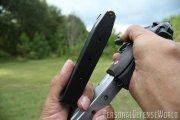 For a Tactical Reload, grab your spare magazine, hold it in your support hand, drop the nearly empty magazine into you support hand, and insert the spare magazine into the firearm. This was originally designed to be used with 1911 single-stack mags but with much practice it can be done with double-stack mags. A Tactical Reload is generally expected to be performed during a lull in a firefight. The idea is to retain the few rounds left in the magazine while getting a full magazine as quickly as possible.
For a Tactical Reload, grab your spare magazine, hold it in your support hand, drop the nearly empty magazine into you support hand, and insert the spare magazine into the firearm. This was originally designed to be used with 1911 single-stack mags but with much practice it can be done with double-stack mags. A Tactical Reload is generally expected to be performed during a lull in a firefight. The idea is to retain the few rounds left in the magazine while getting a full magazine as quickly as possible.
Administrative Reload
An Administrative Reload is generally described as exchanging an (nearly) empty magazine for a fully loaded magazine while the gun is holstered.
Which option you choose may depend on what situation you find yourself in. There are pluses and minuses to each one. Which ever method you use, make sure you position your index finger on the front of the magazine to assist you in aiming the magazine into the mag well. Also, give a tug on the magazine after seating it into the pistol. This ensures the mag is properly seated and doesn’t drop out after the first round is fired. While it is time-consuming and embarrassing (I speak from experience on this one) during a competition, it could be deadly in a firefight.
Which ever option you choose, practice, practice, practice.
Further Resources…
https://www.usconcealedcarry.com/training-tactics/reloading-the-semi-auto-pistol/
http://www.gundigest.com/tactical-gear/essential-pistol-reloading-techniques
http://www.handgunsmag.com/2010/09/24/tactics_training_treload_061604/
http://www.gun-jutsu-training.com/pistol-reload-emergency.html
http://thinkinggunfighter.blogspot.com/2010/03/myth-of-tactical-reload.html
http://www.policeone.com/columnists/POSA/articles/122347-Whats-tactical-about-the-tactical-reload/
http://radioviceonline.com/gun-talk-ten-rounds-in-a-magazine-may-not-be-enough-firearm-realities/
Shopping for a Gun
Posted: December 3, 2013 in Carry Methods, Self Defense, Shooting, Small Business, Women and GunsTags: .22 Long Rifle, .380 ACP, .45 ACP, Christmas, Christmas Shopping, firearm, firearm purchase, gun, gun for Christmas, Gun safety, Gun Shopping, Recreation, Revolver, Shooting sport, Smith & Wesson
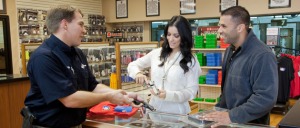
“I’m thinking of buying my wife a gun for Christmas.” is the opening statement I heard today and expect to hear often over the next few weeks. Concerned husbands, anxious for their wife’s protection, are searching for that elusive “good gun for a lady” and see Christmas as the perfect opportunity to buy her something she may or may not be interested in. Before you lay down $400+ on her new gun, please take the following concerns under consideration. This is the mental questionnaire I run through when a customer asks for advice on choosing a firearm.
Purpose:
First and foremost, you must determine the intended purpose of the firearm. Will the gun be used for a self-defense carry gun, home protection, competitive shooting, hunting, just having fun on the range or as a collection piece? Certain features should be prioritized based on which purpose you intend to use the firearm for.

Carry Gun: Typically, light-weight is the priority for a daily carry firearm.
Home Protection: When buying for home protection, weight is less relevant as the gun will only be handled for short durations. The user’s comfort and confidence with the firearm take priority. Home protection guns tend to weigh more, to make the shooting experience more pleasant.
Competitive Shooting: Accuracy, and all that affects accuracy, are what matters most to a competitive shooter. Barrel length, quality, trigger weight, overall weight, etc… are all taken into consideration.
Hunting: Type of game and style of hunting affect your choice of hunting firearm.
Fun Range gun: A gun you are just going to take to the range to have fun is probably going to be something that fits the user’s hand well, has enough weight to balance out the recoil and the user is comfortable manipulating.
Collecting: Collectors typically know exactly what they are looking for. Good luck to you if you are trying to buy for one of these.

When buying a gun, the trick is to find the right compromise of features that works for you. For example, Smith & Wesson Airweights and Ruger LCPs are great for carrying all day, but are so light-weight the recoil is quite uncomfortable. Knowing this fact, I still decided the low-weight was a high enough priority for my carry weapon that I purchased the Smith & Wesson 442 revolver. Do I enjoy shooting it? No. But I can carry it all day with barely a second thought as to the weight, I can carry it in more locations on my body, and it is more reliable than my semi-automatic. Overall, I made an informed decision to put up with the kick in exchange for a comfortable carry gun.
Intended frequency of use:
I ask our customers how often they intend to practice with their firearm in order to narrow the choices down. A revolver is renowned for its ability to sit in a drawer for years and still function flawlessly when called upon. In the same scenario, I’ve seen a semi-auto jam after the first shot. Springs can lose their tension over years of inactivity and the semi-auto design relies heavily on springs. For this reason, whenever a customer says they want a gun for “just in case” and they don’t really want to come shoot it much, I unilaterally direct them towards a revolver. Revolvers are mechanically simpler and more reliable. Buying a small semi-automatic for your wife to stick in her purse but never practice with is asking for trouble.
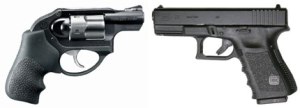
Comfort:
The way the gun feels in the hand and how it feels when shooting are key components in a user’s overall satisfaction with a firearm. This is where the gun buying process becomes quite subjective. The only person who can determine if the gun fits right is the user. There are some guns that just feel good to hold and there are others that are less comfortable to hold. Determining the right fit requires the user to come in and pick up lots of different guns to get a feel for what feels good and what doesn’t feel good to them.
In terms of recoil, weight is your friend. The heavier the gun is, the less recoil your hands have to absorb and the more fun the gun is to shoot. Guys, do me a favor, please do NOT buy your wife that “cute, little .380 ACP.” Those little things have much more recoil than you think. I, personally, would rather shoot a .45 ACP 1911 any day over one of them. Just because they are small does not mean they are good for your wife to start with. Just the opposite in fact. I find beginners do much better starting with heavy firearms and progressing down to light-weight carry guns.
Previous Knowledge/Experience:
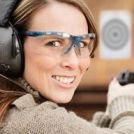 Has the potential user ever received any formal instruction in firearms? I ask this question mostly to determine the user’s level of safety awareness. Formal firearm classes are great for drilling the gun safety rules into heads and habits. In general, I recommend taking classes before the firearm purchase; not only to make sure our customers and everybody around them stays safe with the new gun but classes also makes the user a much more informed consumer. For the gift-buyer, previous experience with firearms can also give you clues as to which type of firearm the person is comfortable with and enjoys shooting.
Has the potential user ever received any formal instruction in firearms? I ask this question mostly to determine the user’s level of safety awareness. Formal firearm classes are great for drilling the gun safety rules into heads and habits. In general, I recommend taking classes before the firearm purchase; not only to make sure our customers and everybody around them stays safe with the new gun but classes also makes the user a much more informed consumer. For the gift-buyer, previous experience with firearms can also give you clues as to which type of firearm the person is comfortable with and enjoys shooting.
Budget:
“You get what you pay for.” This is true for most things in life and especially firearms. That cheap pawn shop gun was cheap for a reason. I have seen such guns literally fall apart on the range. You really do get what you pay for. I understand money being tight, and seeking to find the best bang for your buck, but please save up a little longer or do something to get a little extra money to go towards the firearm purchase. It is much better to have a reliable firearm that your life can depend on than a few extra dollars in the bank.
Physical Limitations:
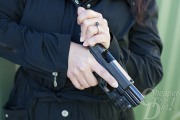 Firearms are mechanical devices and each has a series of manipulations that must be accomplished in order for the device to function properly. Hand, wrist and arm strength are vital. The user must be able to rack the slide on a semi-automatic or pull the heavy trigger of a revolver. Frequently, when a person is not able to do one they can do the other. Occasionally, they struggle with both. At that point, I may suggest, using two fingers to pull the revolver trigger, trying out a .22 caliber firearm or a semi-automatic with an easier slide. If they are still incapable of operating the firearm, I typically suggest they get OC Spray instead of a firearm.
Firearms are mechanical devices and each has a series of manipulations that must be accomplished in order for the device to function properly. Hand, wrist and arm strength are vital. The user must be able to rack the slide on a semi-automatic or pull the heavy trigger of a revolver. Frequently, when a person is not able to do one they can do the other. Occasionally, they struggle with both. At that point, I may suggest, using two fingers to pull the revolver trigger, trying out a .22 caliber firearm or a semi-automatic with an easier slide. If they are still incapable of operating the firearm, I typically suggest they get OC Spray instead of a firearm.
Stopping Power:
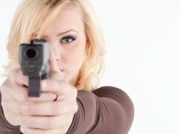 Much is said about the acclaimed stopping power of this round or that round. As I’ve researched it and looked at the statistics, I’ve come to realize what you are carrying is less important than that you are carrying. Many, many bad guys are stopped by .22s. There is something called a psychological stop. Basically, it boils down to the fact that people don’t want to get shot. Typically, bad guys are looking for an easy victim and shooting them suddenly converts you from “easy victim” to “more trouble than it’s worth.” Yes, there are those times when the bad guy is shot multiple times with .45 ACP rounds and keeps coming, however, the large majority of bad guys are cowards looking for easy prey. Odds are in your favor that you will not encounter that zombie-bad guy that just keeps coming, and if you do, good shot placement will help you more than missing with a larger caliber. My conclusion: carry what you can shoot well. If you can shoot a .45 ACP well, carry a .45. If you can only shoot a .22 LR well, then carry a .22.
Much is said about the acclaimed stopping power of this round or that round. As I’ve researched it and looked at the statistics, I’ve come to realize what you are carrying is less important than that you are carrying. Many, many bad guys are stopped by .22s. There is something called a psychological stop. Basically, it boils down to the fact that people don’t want to get shot. Typically, bad guys are looking for an easy victim and shooting them suddenly converts you from “easy victim” to “more trouble than it’s worth.” Yes, there are those times when the bad guy is shot multiple times with .45 ACP rounds and keeps coming, however, the large majority of bad guys are cowards looking for easy prey. Odds are in your favor that you will not encounter that zombie-bad guy that just keeps coming, and if you do, good shot placement will help you more than missing with a larger caliber. My conclusion: carry what you can shoot well. If you can shoot a .45 ACP well, carry a .45. If you can only shoot a .22 LR well, then carry a .22.
Concluding Thoughts
Before you buy that gun you think will be perfect for your loved one, make sure its designed purpose lines up with its intended use. Do your best to accurately estimate how often they will be using the gun. Try to avoid buying a complicated gun for a novice. Keep it Simple. Be sure to consider any physical limitations they may have. Balance the pro’s and con’s of each firearm to ensure a good match of user and firearm is made. A mismatch may make the user uncomfortable, insecure, and mistrustful of guns in general.
A little tip for all you gift-buyers out there, we see a much higher rate of success when the intended user is involved in the decision-making process. If you can successfully buy her a pair of shoes then you stand a pretty good chance with buying her a gun. If not, please bring the intended user in with you. Only she will know what feels right to her.
